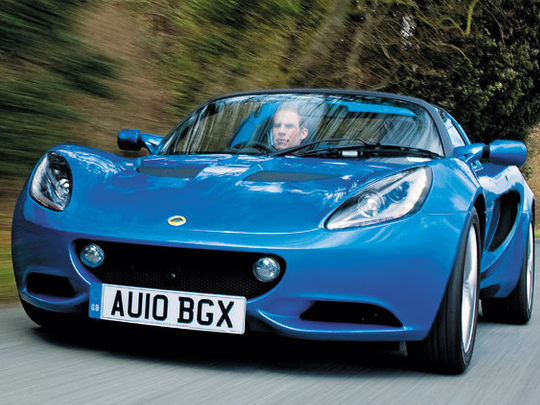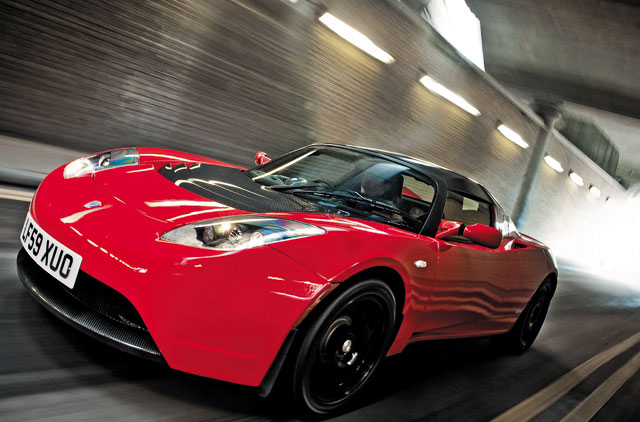
The phrase ‘game-changing' is thrown around a lot in technology circles. Used to depict something new, it's nearly always the description of choice of our Stateside friends.
But for once it's appropriate that Tesla's Roadster has been described as something of a game-changer in automotive circles. It was only recently that the all-electric roadster exploded onto the scene, demonstrating supercar levels of performance and a range that could rival a hard-driven petrol-powered alternative.
The Lotus Elise in the meantime, already changed the game ages ago. The small Hethel-based sportscar manufacturer's most successful model by some margin has accounted for 30,000 sales over the last 14 years. Admittedly that doesn't sound particularly impressive but, remember: Lotus is a small, specialist manufacturer. As such, 30,000 units account for some 33 per cent of all the cars Lotus has ever built.
Tesla itself was equally revolutionary; eschewing the usual automotive business plan, the company's rise to fame had more in common with a well-funded internet start up than a traditional bricks and mortar organisation.
The firm's American roots, specifically California's in Silicon Valley, have only served to add a layer of excitement to proceedings. The car itself has its origins much further away — in the very same Lotus facility in deepest Hethel.
Tesla realised that it couldn't do everything itself and sought the best in the business for help. Lotus is renowned the world over for its engineering skills, so now you know why the Roadster looks a lot like a long wheelbase Elise.
What we have with the Roadster Sport is a two-seat, rear-wheel drive sportscar clad in lightweight composite panels. Power comes from a Tesla designed 375-volt motor, which translates into 288bhp in the real world. However, being an electric motor, response is near-instant as is the torque delivery — the motor develops 400Nm of twist.
With these numbers it's hardly surprising the car posts such eye-popping performance figures. The 100kph sprint comes up in a supercar-rivalling 3.7 seconds, with top speed limited to a respectable 201kph. The lighter, smaller and slightly more agile 2011 Elise comes just 1kph short of that. But it should be a bigger gap, since the Lotus houses a smaller 1.6-litre engine — down from the previous 1.8-litre.
The Elise's mid-engined, rear-wheel drive layout — as in the Tesla — remains the same, but what changes there are, are minimal. After all, it's what gives both these cars their legendary balance. A super-lightweight aluminium chassis and composite body panels contribute to an un-laden mass of just 876kg for the Lotus, so the all-new 136bhp engine has less strain. While the Elise may be small in stature, it's one of the sharpest and most universally appealing designs money can buy. The Tesla looks more menacing, more butch and heavier next to the lithe Lotus. Once you get around the styling, all similarities end.
After some initial teething troubles with its two-speed transmission, the Tesla now boasts a single-speed unit. Inside there's a push-button control for Reverse, Neutral and Drive, while a small touchscreen display shows range, power consumption, status and allows the driver to switch between three driving programmes — economy, regular and sport.
The Lotus makes do with an extra spartan interior and a six-speed manual. In a car that really needs to be driven in the middle gears to exploit its finely-tuned and hand-crafted abilities, it seems like a strange addition.
No such worries with the insta-torque Tesla. Simply put, the Roadster is an addictive experience. Once you've turned the key, waited for the car to power up and thumbed ‘D', everything else feels prehistoric by comparison.
Rapid acceleration is accompanied by the distant whine of the transmission. It's a good job the speedo is big as you'll need to be checking it often. The car's Elise foundations do it no harm in the handling department, while the battery's mass does much to cancel out the donor car's slightly skittish behaviour over less than smooth roads.
On the road in the Lotus, its Toyota unit feels subdued one moment and raucous the next. It responds best to being revved hard, with a noticeable extra kick above 5,000rpm on the way round to the 7,000rpm rev limit. Sitting happily at 6,800rpm, its position behind the cockpit means you feel the revs build through your backside and up your spine, helping find the car-builder's Holy Grail of making the driver feel like part of the car.
And thrills aren't the only thing the unit is delivering, either. CO2 emissions are down to 149g/km, and no other sportscar can genuinely equal that. Well, no petrol-engined sportscar, that is. Because the electrifying Tesla is a zero-emissions vehicle. Factor in its direct steering — less feelsome that the Elise's unit though, thanks to the extra weight — and you're guaranteed a ball on the road. Even the brakes are special: the power regeneration effect renders them almost unnecessary at low speeds. The sensation is akin to engine braking from a high compression diesel motor — and then some.
In the Lotus, braking hard through a tightening bend, you control it as much with your steering inputs as with the right foot. It's skittish, nervous, and the Tesla planted.
The American ‘Lotus' then is not only fast, in fact much faster than the Elise, but also surprisingly more docile than the Brit at urban speeds. It's also practical, what with its decent range and flexible charging options. Yes, it is expensive, but no more so than something petrol-powered with the same performance.
But it's missing that link between driver and car that the Lotus delivers. Short, precise shifts and a connected feel make the Lotus more of a sporting pleasure to handle. For pure driving bliss, the Lotus Elise has always been a hard car to improve upon. Tesla tried, and didn't really improve, but rather changed the game. There we go again with that phrase…
Lotus on the other hand, took the old route, with cutting edge new styling and a more efficient but equally entertaining engine and transmission package.So what we've proven here basically is that although the driving dynamics are spot on for both models, these cars still couldn't be more similar. Or different.
Specs & rating
Model: Roadster Sport
Engine 375-volt electric motor
Transmission Single-speed RWD
Max power 288bhp @ 14,000rpm
Max torque 400Nm @ NA
Top speed 201kph
0-100kph 3.7sec
Price Dh472,000 (US)
Plus Greenest sportscar
Minus Expensive
Specs & rating
Model 2011 Elise
Engine 1.6-litre inline-four Transmission Six-speed manual RWD
Max power 134bhp @ 6,800rpm
Max torque 160Nm @ 4,400rpm
Top speed 200kph
0-100kph 6.7sec
Price Dh154,000 (UK)
Plus Still the purest, and most bang-for-buck sportscar
Minus Too minimalist for some












